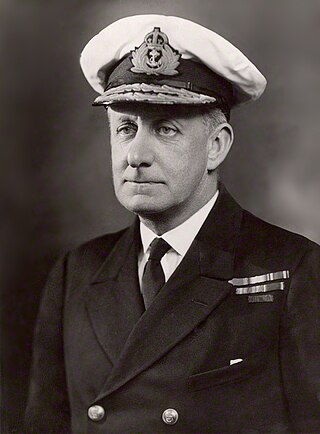
The British Mediterranean Fleet, also known as the Mediterranean Station, was a formation of the Royal Navy. The Fleet was one of the most prestigious commands in the navy for the majority of its history, defending the vital sea link between the United Kingdom and the majority of the British Empire in the Eastern Hemisphere. The first Commander-in-Chief for the Mediterranean Fleet was the appointment of General at Sea Robert Blake in September 1654. The Fleet was in existence until 1967.

Vice Admiral Sir Geoffrey Schomberg Arbuthnot, was a senior officer in the Royal Navy.

The Commander-in-Chief, The Nore, was an operational commander of the Royal Navy. His subordinate units, establishments, and staff were sometimes informally known as the Nore Station or Nore Command. The Nore is a sandbank at the mouth of the Thames Estuary and River Medway. In due course the Commander-in-Chief became responsible for sub-commands at Chatham, London, Sheerness, Harwich and the Humber.

The Commander-in-Chief, Portsmouth, was a senior commander of the Royal Navy for hundreds of years. The commanders-in-chief were based at premises in High Street, Portsmouth from the 1790s until the end of Sir Thomas Williams's tenure, his successor, Sir Philip Durham, being the first to move into Admiralty House at the Royal Navy Dockyard, where subsequent holders of the office were based until 1969. Prior to World War I the officer holder was sometimes referred to in official dispatches as the Commander-in-Chief, Spithead.
Admiral Sir Walter Thomas Couchman, was a Royal Navy officer who served as Vice Chief of the Naval Staff from February to November 1960, when he retired from service.

The Eastern Fleet, later called the East Indies Fleet, was a fleet of the Royal Navy which existed between 1941 and 1952.
HMS Aggressive was a shore establishment of the British Royal Navy during World War II, based at Newhaven, East Sussex.

Vice-Admiral James William Rivett-Carnac CB CBE DSC DL was a Royal Navy officer who became Commodore commanding the New Zealand Division.

The Assistant Chief of the Naval Staff (A.C.N.S.) is a senior appointment in the Royal Navy usually a two-star rank and has a NATO ranking code of OF-7.
The Commander in Chief, Dover was an operational commander of the Royal Navy. His subordinate units, establishments, and staff were sometimes informally known as the Dover Command.

The Commander-in-Chief, Levant was a senior administrative shore commander of the Royal Navy. The post was established in February 1943 when the British Chiefs of Staff Committee ordered the Mediterranean Fleet to be divided into two commands. One was responsible for naval operations involving ships, and the other, administrative and support, was responsible for shore establishments. His subordinate establishments and staff were sometimes informally known as the Levant Command or Levant Station. In December 1943 the title was changed to Flag Officer, Levant and East Mediterranean. In January 1944 the two separate commands were re-unified into a single command merging back into Commander-in-Chief Mediterranean Fleet.
The Commodore-in-Charge, Algiers was an administrative shore based appointment of the British Royal Navy established during World war II who was responsible for the berthing of all British convoys in Algeria and its sub-commands, facilities and staff from 1942 to 1946. The post holder was based at Allied Force Headquarters, Algiers. It was at first a sub-command of the Commander-in-Chief, Mediterranean Fleet then later the Commander-in-Chief, Levant.

The Rear-Admiral, Alexandria was an administrative shore based appointment of the British Royal Navy. The post was established during the Second World War, subordinate to the Commander-in-Chief, Mediterranean Fleet then later the Commander-in-Chief, Levant.
Brighlingsea Naval Base was an installation of the British Royal Navy located at Brightlingsea, Essex, on the East Coast of England. In both wars it was part of the Nore Command, which had its HQ at Chatham, and in the Second was part of Harwich Sub-Command. It existed from late 1914 to 1921, and from early 1940 to 1947,
The Flag Officer-in-Charge, Humber was a Royal Navy officer who administered naval forces located at Immingham and Grimsby, Lincolnshire, England. His formation was sometimes known as the Humber Station or Humber Area. In World War I it was a sub-command of the Admiral of Patrols from 1914 to 1916, then came under the Commander-in-Chief at the Nore until 1921. In World War II the FOIC was responsible to the Commander-in-Chief, The Nore.

The Red Sea Station was a military formation of the Royal Navy. At various times it has also been referred to as Egypt Division and Red Sea and later the Red Sea and Canal Area. The Royal Navy had distinct formations for the Red Sea at intervals from 1846 until circa 1944-45.
The Senior British Naval Officer, Suez Canal Area was an administrative appointment of the Royal Navy established during World war II who was responsible for the naval base HMS Stag at Ismailia, Egypt. The SBNO was subordinate to the East Indies Station from 1939 to 1941 then the Mediterranean Fleet until 1942.

British Naval Forces Germany was a command of the Royal Navy that was active from 1944 to 1961 under three titles.
James Murray Pakenham Pipon KBE CMG MVO was a Royal Navy officer who served in World War I and, after being recalled to active duty in 1940, World War II.






